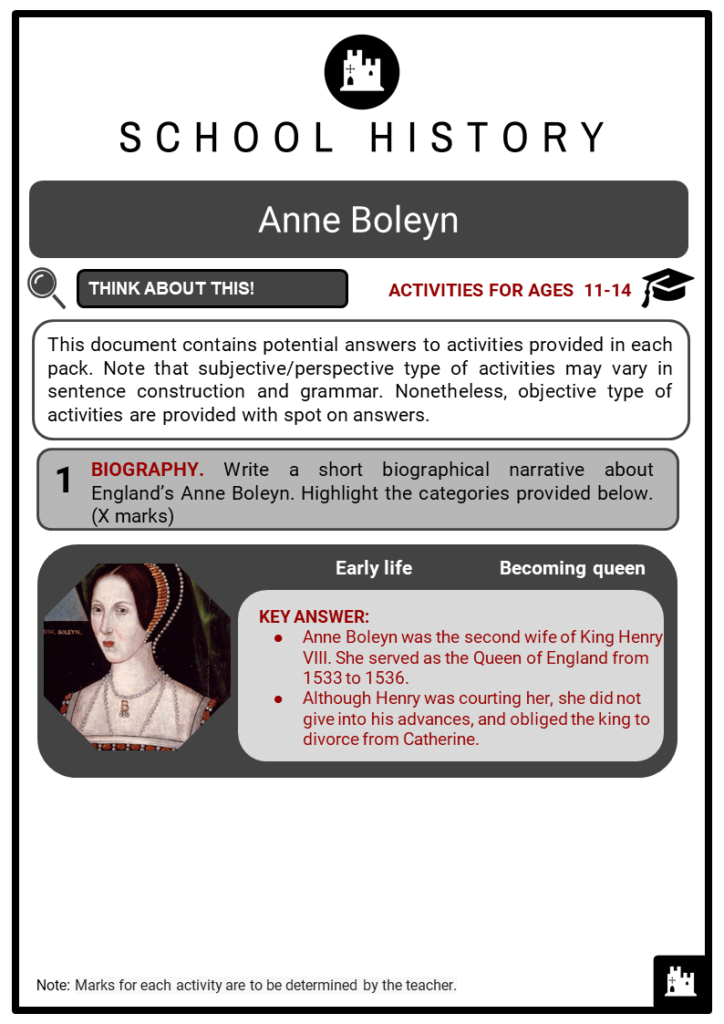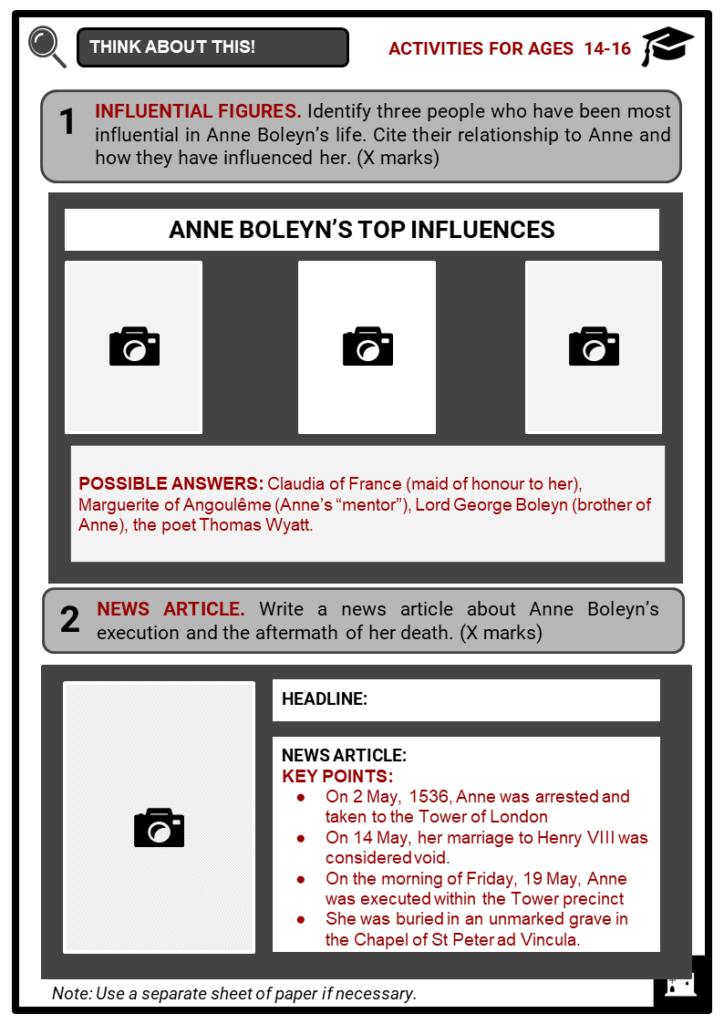Download Anne Boleyn Worksheets
Do you want to save dozens of hours in time? Get your evenings and weekends back? Be able to teach Anne Boleyn to your students?
Our worksheet bundle includes a fact file and printable worksheets and student activities. Perfect for both the classroom and homeschooling!
Table of Contents
Add a header to begin generating the table of contents
Summary
- Who was Anne Boleyn?
- How did Anne Boleyn become Queen of England?
- What is the cause of Anne Boleyn’s death?
Key Facts And Information
Let’s find out more about Anne Boleyn!
- Anne Boleyn was the second wife of King Henry VIII. She served as the Queen of England from 1533 to 1536.
- Anne Boleyn received an outstanding education in the Netherlands and in the French court.
- She met Henry VIII at a very young age whilst he was still married to Catherine of Aragon.
- Although Henry was courting her, she did not give into his advances, and obliged the king to divorce from Catherine.
- Anne was not able to provide Henry with any male heirs. However, she gave birth to Elizabeth I.
- Anne was executed on charges of high treason in 1536.
Anne’s Early Life
- Starting from 1 January 1515, Anne served as maid of honour to the fifteen-year-old Claudia of France, queen consort of the King Francis I.
- During her stay at the French court, Anne learned the French language and developed an interest in art, manuscripts, literature, music, poetry and religious philosophy. She also acquired knowledge regarding French culture, dance, etiquette and courtly love.
- During this period, she met Marguerite of Angoulême (sister of King Francis I of France), patron of humanists and reformers, as well as a poet and writer herself. The quality of education that Anne received was demonstrated on her return home when she inspired new thoughts and fashions among the ladies of the English court.
Anne’s return to England
- In January 1522 Anne was called back to England in order to marry her Irish cousin, several years older than her, James Butler, who lived in the English court. However the plan failed and the marriage was not celebrated, perhaps because Sir Thomas Boleyn, Anne’s father, hoped for a more illustrious marriage for his daughter.
- Whatever the reason, the negotiations went up in smoke and James Butler married Lady Joan Fitzgerald, daughter and heir of James Fitzgerald, 10th Earl of Desmond, while Anne, still a maiden, became the companion of Catherine of Aragon, Spanish queen consort of Henry VIII, King of England.
- Anne made her official debut at the court on 4 March, 1522, participating, along with her sister Mary, in a dance organised in honour of the imperial ambassadors.
- The dance was a masque, a sort of theatrical performance very popular at the time, where a theme was chosen on the basis of which each participant was given a role.
- In Chateau Vert, Anne had to play the part of Perseverance. On that occasion, everyone wore white satin dresses embroidered with gold threads.
- The grace and beauty exhibited by Anne during the dance were such that she was considered one of the most elegant women of the court.
- Among her admirers was Henry Percy, 6th Earl of Northumberland (son of Henry Algernon Percy, 5th Earl of Northumberland), with whom Anne secretly became engaged around 1523.
- Given the social disparity, their relationship was opposed by Percy’s father. In January 1524, Cardinal Thomas Wolsey, who young Henry was a pupil of, prevented them from marrying.
- There was also talk of a relationship between Anne and the English poet Thomas Wyatt, who had grown up in the castle of Allington, in Kent, in the immediate vicinity of Hever Castle.
King Henry VIII falls in love with Anne Boleyn
- In the spring of 1526 King Henry VIII, who had fallen in love with Anne, began to court her insistently and encouraged her to become his mistress.
- However, Anne refused his advances. The ambitious young woman knew that the king’s infatuation was a great opportunity to be exploited: she was aware of the fact that if she consented to his requests, she would simply be one of her many lovers (as had happened to her sister Maria). Therefore, she decided to encourage Henry VIII to separate from his wife Catherine of Aragon so that, free from any marriage bond, he could propose to Anne, making her the new queen of England.
Marriage to Anne Boleyn
- It has often been thought that Henry’s infatuation with Anne was the only reason for the marriage annulment with Catherine, but another reason could have pushed the king in that direction: the queen’s inability to give him a male heir.
- After many abortions and miscarriages, Catherine managed to give him only one daughter, Mary I of England.
- Since the pope did not want to annul the marriage between Catherine of Aragon and Henry VIII, it can be said that Anne Boleyn was one of the main causes of the break between the Church of England and Rome.
- On 25 January 25, 1533, King Henry married Anne in London. Also, in this case, certain confidentiality and secrecy was maintained, to the point that to this day we do not know exactly where the wedding was celebrated.
- In any case, the marriage was not made public until April, shortly before the coronation of Anne as Queen of England.
- Anne Boleyn’s life at court was characterised by luxury and magnificence. Over 250 people were at Anne’s service. She invested large sums of money in clothes, jewellery, hats, peacock feathers, riding articles, equipment, furniture… Numerous buildings were also renovated in order to satisfy the extravagant tastes of Anne.
- The relationship between King Henry and Anne was stormy: periods of tranquillity and happiness alternated with periods of tension and quarrels, mostly due to Henry’s repeated infidelities, which led Anne to violent outbursts of tears and anger. Likewise, Henry considered Anne’s marked intelligence and political acumen to be very irritating.
- Following the birth of Elizabeth, the consorts believed that they would have other children, including the much-desired male heir, but the second pregnancy ended in a miscarriage in the summer of 1534.
- The king began, then, to believe the gossip about Anne’s inability to give him a male child and discussed with Cranmer and Cromwell about separating from her without having to return to
- The royal couple, however, reconciled
- and in October 1535 Anne discovered she was pregnant again. Unfortunately for her, this
- pregnancy also ended in a miscarriage. The news
- of the abortion of a male child caused an irreversible deterioration of the marriage with the king who, convinced beyond any doubt about Anne’s inability to give him an heir, began to consider their marriage the fruit of a spell, and therefore, cursed by God.
- Already in March 1536, Henry VIII began to court lady Jane Seymour, who would become his third wife. It seems that the king had given his new lover a medallion with a miniature portrait of himself inside.
Anne Boleyn’s death
- From April 1536, Anne was investigated for high treason, and on 2 May, 1536, around noon, she was arrested and taken to the Tower of London in a boat, where she was entrusted to the custody of William Kingston.
- The following were then arrested on the charge of being lovers of the queen: Lord George Boleyn (brother of Anne), Mark Smeaton (court musician of Flemish origin), the poet Thomas Wyatt, Henry Norris (courtier of the Crown Chamber and friend of the king since childhood), Francis Weston (a young gentleman belonging to the intimate circle of the queen), William Brereton and Richard Page (both courtiers of the King’s Private Chamber).
- Anne spent the last days of her life locked up in the Tower of London.
- At the time of execution, on 19 May, 1536, Anne knelt upright (according to the French style of executions, which did not include a log on which to rest her neck) while repeating the prayer “To Jesus Christ, I commend my soul; Lord Jesus, receive my soul“.
- Then the ladies who had accompanied her took off her hat (but not the bonnet, which held her hair and left her neck free) and the necklaces, while another lady tied a bandage over her eyes.
- Suddenly the executioner brandished his sword with a gesture that astonished the crowd, since no one had noticed the weapon so far, almost giving the impression that it had magically materialised in his hands at that moment.
- In reality, the executioner had hidden the sword between the straw scattered at the foot of the log and his gesture could be explained with the intention of catching the condemned by surprise, and avoiding her prolonging the anxiety of waiting, as well as any sudden movements.
- Moreover, to prevent Anne from turning her head instinctively back at the time of beheading, the executioner shouted to the crowd in front of the gallows “Bring me the sword”, so that she would look forward, keeping her neck straight.
- In that exact moment, the executioner lowered the sword and cut her head.
- A lady covered the queen’s head with a white cloth, while the others took care of the body.






